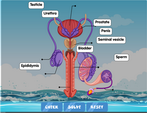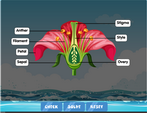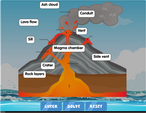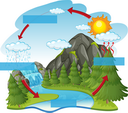Label parts of a fish diagram quiz
Fish live in a pretty different part of the world. While terrestrial, or land-based, creatures such as humans can only stay underwater for a few minutes, fish are natural inhabitants of the sea.
Species of fish vary wildly from one another, but they share key features that fish use to properly move, swim, breathe, eat and reproduce underwater.
All fish have gills instead of lungs. When a fish breathes, it lets water enter its mouth and pass over the gills, which collect oxygen from the water before opening to release it.
To move gracefully in the water, fish have fins on many parts of their body. Fins can be found on their back, tail, chest, or hip. They assist the fish in steering in different directions, staying still, and stopping quickly.
Many fish also have scales that protect them from injury. Some scales are jagged and pointy, while some have rounded edges. Scales are often coated in a slimy, snot-like substance that shields them from infection.
This label parts of a fish diagram quiz can assist you in understanding the different structures found in a fish’s anatomy, and the functions they perform to help fish live in their marine environment.











